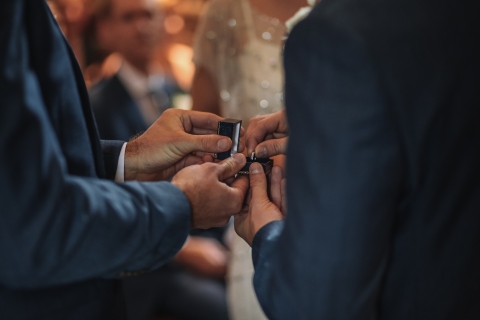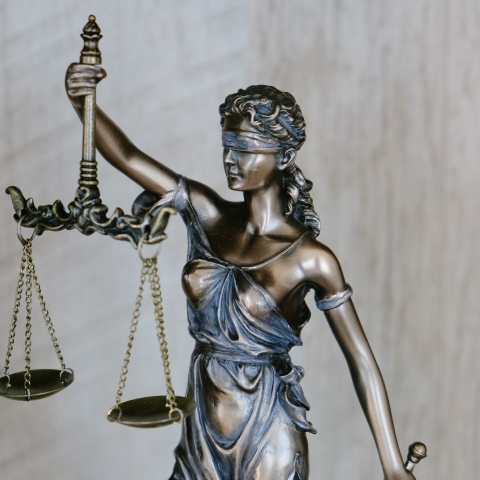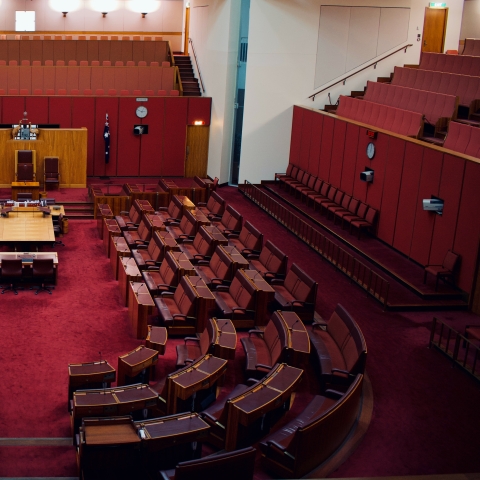

In his latest blog, Dr Michael Connolly discusses the the ‘clash of rights’ caused by the case of a wedding website provider who was entitled to refuse to build a site for same-sex weddings.
5 minutes
In another event of the ‘clash of rights’ between freedoms of free speech and religion, and freedom from discrimination, the US Supreme Court held in 303 Creative v Elenis (2023) that a wedding website provider was entitled to refuse to build a site for same-sex weddings. A 6-3 majority held that Colorado legislation outlawing discrimination in the provision of services did not apply because it would infringe the providers’ First Amendment rights of free expression, given the ‘expressive’ nature of the service. The person behind the business, Lorie Smith, held a religious belief that same-sex marriage was ‘false’.
The minority dissent (written by Justice Sotomayor) held that any ‘expression’ in providing the service was merely incidental, and thus the refusal amounted to unlawful discrimination based on sexual orientation. Both the majority and minority reached out to the extremes in support of their decisions, with the majority Opinion (written by Justice Gorsuch) citing precedents of infringement of expressions not in the public provision of goods and services (e.g. obliging schoolchildren to salute the flag, Boy Scout membership, participation in a Veterans’ parade) (pp7-8). Meanwhile, Justice Sotomayor invoked unlawful refusals to admit minorities or women by a motel, restaurant, and private school (18). These, of course, covered only the refusal to serve a protected class of persons.
Each side then invoked the dire potential of the other’s reasoning. For the majority, it would mean forcing ‘an unwilling Muslim movie director to make a film with a Zionist message, or ‘an atheist muralist to accept a commission celebrating Evangelical zeal’ (11-12). This misunderstood the subtlety of the dissent, Justice Sotomayor claimed, which was that Smith, through her company, was perfectly entitled to publish any message she liked, but was not entitled to refuse service for same-sex couples (27-28). Moreover, Justice Gorsuch’s ‘unwilling Muslim’ was not someone offering a service to the public in general. In turn, Justice Sotomayor predicted that that the majority’s logic extended to the refusal to supply services for an interracial marriage, (37) another prejudice informed by religion, long thought to be outlawed in the provision of goods and services. For Justice Gorsuch, such fears were ‘pure fiction’ (21).
The case is remarkably similar to one decided in the UK Supreme Court, Lee v Ashers (2018), where a Christian bakery refused to supply a cake iced with the words ‘Support Gay Marriage’. Handing down a unanimous judgement dismissing the claim of sexual orientation discrimination, Lady Hale wrote that the refusal was about ‘the message and not the man’. Without much in the way of precedent, Lady Hale also invoked some extreme examples, such as a Christian printer being forced to produce atheist leaflets (para 47).
The message or the man?
Lee v Ashers can be distinguished as a case much more about the ‘message’ on the cake, rather than the cake itself. The matter would have been different, Lady Hale suggested, had the bakery refused to supply a cake for a same-sex wedding, thus discriminating against the gay men, rather than the gay message. By contrast, 303 Creative involved both the ‘message and the man’ by refusing to supply the service to a same-sex couple. Moreover, the majority in 303 Creative were less exercised by this distinction. It would seem that as long as the service involved a form of expression, the First Amendment rights were invoked. A similar sentiment was expressed by some of the Justices in another US Supreme Court case, Masterpiece Cakeshop v Colorado Civil Rights Commission (2018). This involved a refusal to supply a cake for a same-sex wedding (but turned on the state hostility to the bakery’s religious belief). Here, three of the 6-2 majority expressly rejected the message distinction (1735, 1743-1745) with Justice Gorsuch finding it ‘irrational’, because no one could ‘reasonably doubt that a wedding cake without words conveys a message... it celebrates a wedding’ (1738). In short, a majority (3-2) of those who were concerned enough to cast an opinion were against the distinction. Just two from a court of eight favoured it, and they were the dissenters (Justices Ginsburg and Sotomayor).
It may seem odd that although Lady Hale and Justice Sotomayor came to opposite decisions, they did so on a shared factual analysis of distinguishing the message from the man. This can be explained by their differing legal analyses, discussed next
The consequence of assuming discrimination
The technical difference between the US and UK cases is that the UK Supreme Court held that there was no discrimination in the first place (the message not being associated closely enough with just homosexual persons, as others also supported gay marriage). This disposed of the need to ‘go upstairs’ to consider the bakery’s rights of free speech and religion (via the Human Rights Act 1998). This may prove significant, because a consideration of the defendant’s rights at least permits an evaluation of the context and aims of the challenged law, including the notion of proportionality. It could be used to prevent the more pernicious scenarios, such as those envisaged on both sides of the debate. Other ‘message cases’ could include a refusal by all bakers in the town to supply the slogan, or others such as Support the Polish Veterans, or Support the Synagogue, with the result of marginalising as social outcasts homosexuals, recent immigrants, or Jews, as the case may be. If such messages were found to be supported by a broader constituency, refusals cannot be challenged as they are not considered to be discriminatory.
That said, Lady Hale hinted heavily that had the refusal been discriminatory, the baker’s human rights of expression and religion would prevail, although little analysis was offered ([55-56]). This suggests, if she were sitting in the US Supreme Court, it might even be that the notably progressive Lady Hale would be in agreement with notably conservative Justice Gorsuch, one of the three Trump nominees.
Can the message be distinguished from the man (or the cake)?
Back in the United States, the result of 303 Creative may have broader implications. Justice Gorsuch was keen to assert that the decision was confined to free speech cases, hence his labelling of Justice Sotomayor’s fears as ‘fiction’. However, suggesting that free speech cases do not involve the rejection of minorities or women is somewhat optimistic, if not disingenuous. It is true that in 303 Creative the wedding websites would be customised and tailored through collaboration with individual couples, and express the provider’s message celebrating and promoting its view of marriage. But while this involved the provider’s ‘expression’, it also meant refusing the service to same-sex couples (even if, as asserted, the provider would refuse same-sex wedding websites to all-comers). There will also be cases where the expression is implicit, such as an unadorned wedding cake (suggested by Justice Gorsuch Masterpiece). On this basis, it is difficult to imagine the service without some form of expression. For example, a motel owner refusing minorities is expressing more generally that he is racist (perhaps a religious-based belief in segregation).
Another consequence of the decision is that the likes of Lorie Smith can display notices expressing their prejudices of, say racism or sexism. This is not a value judgement re-sexual orientation, but merely highlighting evils thought to have been slayed long ago. Meanwhile, Justice Sotomayor envisaged the child of a same-sex couple witnessing a notice, We Do Not Provide for Same-Sex Weddings. The Justice lamented, ‘What message does that send?’ (35)
Reversing the scenario and employment discrimination
These cases are rooted in the notion that a provider of services can discriminate if informed to do so by their freedom of religion or expression. It raises the question of whether the principles can apply to the reverse scenario, where, instead of the defendant, it is the claimant raising their religious rights in relation to sexual orientation. For example, an employee could be disciplined or dismissed for refusing to undertake any duties recognising same-sex relationships. One might ask, while it was lawful for the bakery to refuse to supply the message, what if an employee working for a compliant bakery refused, and was dismissed as a result? Likewise, an employee working for a compliant website provider. Here, courts seem less inclined to prioritise the religious manifestations, or ‘expressions’, of the employee. In Ladele v London Borough of Islington (2010), for her religious reasons, a registrar declined to undertake same-sex civil partnership ceremonies, and was disciplined as a result. Her claim for religious discrimination was rejected, with the employer’s diversity policy prevailing.
Similarly, in the United States, in Peterson v Hewlett-Packard (2004) a Court of Appeals held it legitimate to dismiss a worker displaying biblical quotes condemning homosexuality contrary to its diversity policies. To hold otherwise would have ‘infringed upon the company’s right to promote diversity and encourage tolerance and good will among its workforce’ (608). It would seem that in both jurisdictions a supplier has more leeway than a worker to manifest their religious beliefs in sexual orientation inequality
Conclusion
While it is well known that the First Amendment plays a more dominant role in the United States, despite Justice Gorsuch’s denials, 303 Creative suggests that it could engulf nearly all cases of the supply of goods and services, as they could be interpreted to involve at least some element of expression. Moreover, as the Justice himself stated in a previous case, the expression could be implicit, such as that provided by an unadorned wedding cake.
Justice Sotomayor’s distinction between the ‘message and the man’ is designed to marginalise the speech element as incidental, thus allowing the discriminatory element to prevail. This is slightly different from Lady Hale’s purpose in the distinction, which was to marginalise the discriminatory element in the refusal. Nonetheless, it would seem that the essence of these rather technical differences is the ‘clash of rights’ religious doctrines refuting the legitimacy of same-sex relationships and deeply established legislation validating them. Although, it should be noted that employees have less ‘freedom’ to manifest their discriminatory religious beliefs than a supplier of goods and services.
Finally, it should be noted that both jurisdictions accept that a limited company, an artificial legal personality, such as the businesses involved in these two cases, can hold a religious belief, despite otherwise being legally distinct from their owners and management
Other Law blog articles
A more conventional Attorney-General
James Hand
15 January 2023
5 minutes

Message or the Man (or the Cake)?
Message or the Man (or the Cake)?
21 December 2022
4 minutes

ICC upholds jail term for Ugandan rebel commander Ongwen - why it matters for Africa
17 December 2022
4 min read

